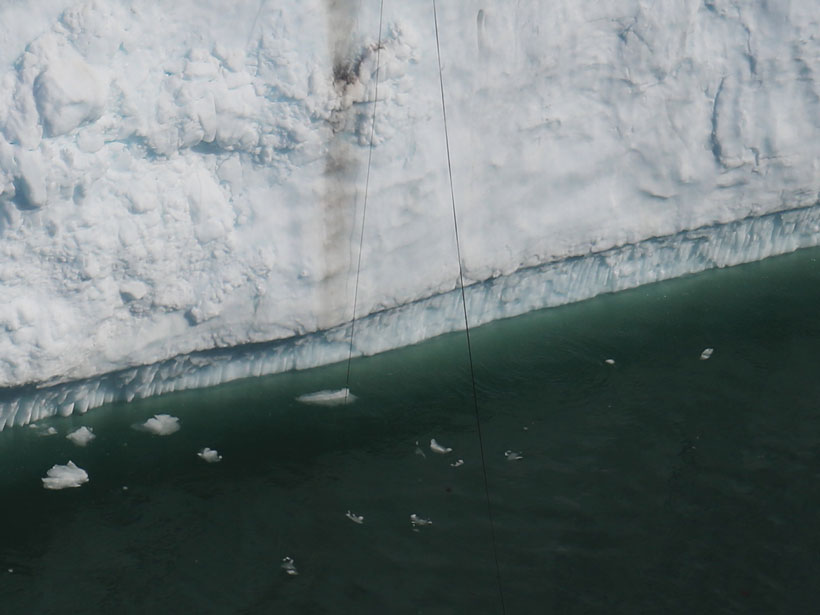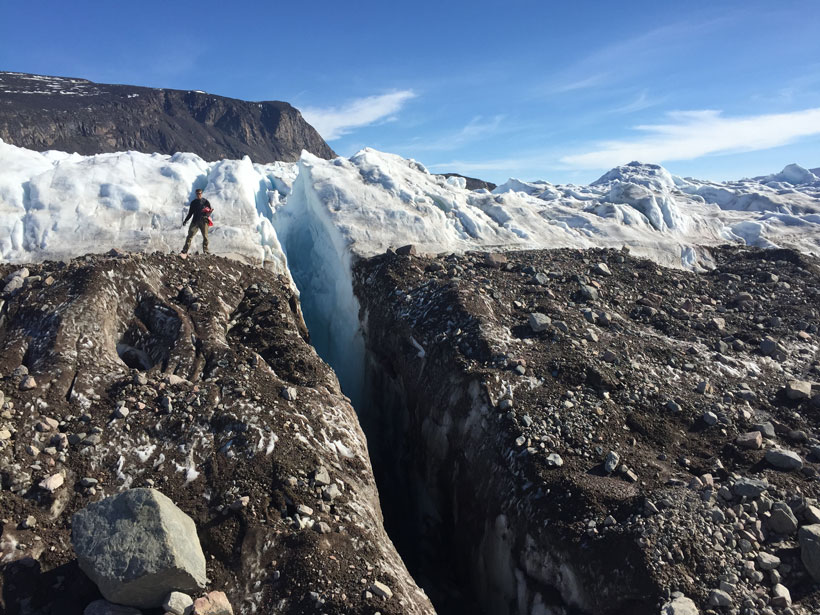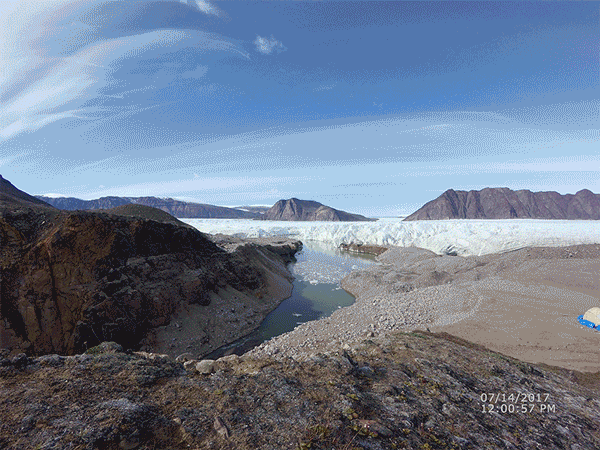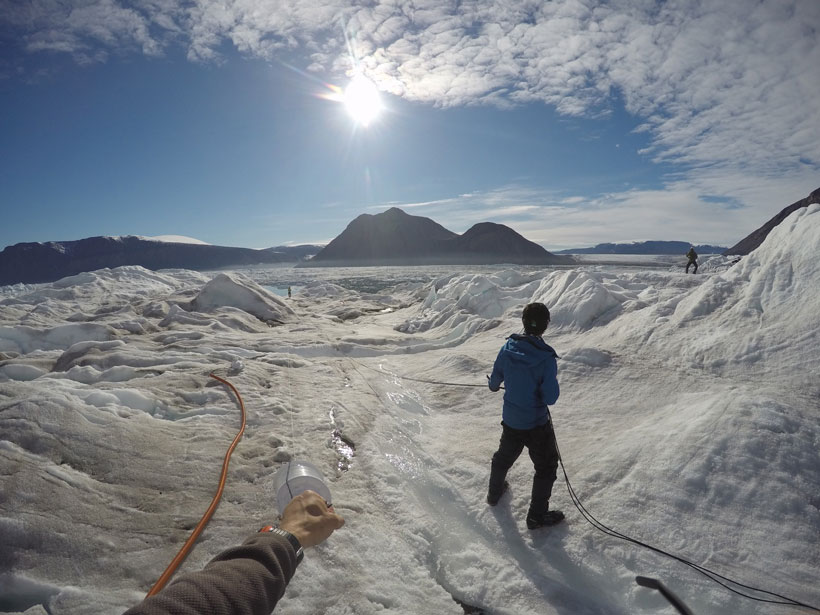While enjoying a fondue dinner next to Bowdoin Glacier, researcher Evgeny Podolskiy watched as a nearby ice-dammed lake slowly drained.

Bowdoin Glacier is one of approximately 250 marine-terminating glaciers in Greenland, and what Podolskiy witnessed was the result of a subglacial discharge plume, a unique feature of marine-terminating glaciers. The glacier’s melting surface water falls through its crevasses and cracks into channels and exits underneath, at the glacier’s edge, where it mixes with salty fjord water. When the freshwater from the glacier combines with the salty water, they create a convective plume, like a chimney, and can form pools. If the plume’s deep water is warmer than its shallower water, it can quickly melt ice, which can cause a piece of the glacier to break off into the ocean.
These Arctic subglacial plumes “are key drivers of fjord-scale circulation,” said Podolskiy, assistant professor at the Arctic Research Center of Hokkaido University, yet much about their long-term activity, how they change, and how they affect the underwater environment has been a mystery.
Podolskiy and his colleagues wanted to know what was really happening in subglacial plumes and their effects on their environments, but glaciers are dangerous and unstable places, making them difficult for scientists to study. Marine-terminating glaciers, in particular, move very quickly—for example, Bowdoin moves 1–3 meters every day. It also has many crevasses into which researchers could fall. However, what makes Bowdoin Glacier unique is that one area of its calving front can be reached by foot. “So we can do things which not many glaciologists could imagine,” said Podolskiy.

Previously, data on subglacial plumes had been limited to very brief, episodic periods, and a full picture of plumes had not been achieved. In an effort to get a “continuously updated image” and not just “snapshots” of subglacial plumes, the researchers devised an innovative method to gather longer-term data that involved hanging two sensors from a 30-meter ice cliff. One sensor was hung at 5 meters below the glacier’s calving front, and the second, deepwater sensor was hung at 100 meters in the water of an ice-dammed lake, and they were left there for 18 days. The researchers also set up a camera to capture time-lapse images of the lake every minute. This was the first continuous sensor monitoring done at a calving front, and the results were published in Communications Earth & Environment.
Feasts for Birds
What the authors discovered was chaos and disruption beyond what they had imagined. The sensors recorded extremely irregular and dramatic activity—bursts of warm water from under the glacier formed pools near the calving front, which would be sucked back under hours later by the plume, triggering a seismic tremor lasting several hours. In addition, tides, tremors, and wind all affected the plumes’ activities, the authors discovered. The plumes regularly spit out the sensors to the surface, which were also periodically dragged by nearby icebergs that caught the sensors’ cables in passing. These challenges are why the researchers have only 12 days of data, rather than 18 as planned. “This kind of time-lapse profiling of the water column is extremely unusual, to my knowledge, especially near the surface, because near the surface, your sensors are just destroyed by these icebergs,” said Podolskiy.
“The time series is critical, because if you just have the snapshots, you don’t know clearly what’s going on there.”
These plumes also push nutrients, sediments, and organisms to the surface, including zooplankton on which birds feast. Occasionally, Podolskiy found deepwater fish with exploded eyes near the coast because of the change in pressure. “One of the most amazing things I saw in this Arctic desert [was] the formation of foraging hot spots,” he said. “You may see above this brownish water hundreds of birds and seals attracted to it, because it brings things up from the deep ocean.”
Ken Mankoff, a scientist at the Geological Survey of Denmark and Greenland who works in similar environments but wasn’t involved in the study, called the approach “innovative and elegant.” He added, “The time series is critical, because if you just have the snapshots, you don’t know clearly what’s going on there.”

Only in the past decade have researchers begun to realize how much glaciers affect the ocean, Podolskiy said, yet predictive models that are currently used are based on very brief timescale data captured in deeper, calmer waters. He hopes this research will prompt more longer-term observations of subglacial discharge plumes. “How do you assess the future of glaciers when we are not even sure what the systems are doing, really?” asked Podolskiy.
—Danielle Beurteaux (@daniellebeurt), Science Writer
21 May 2021: This article has been updated to correct the creation and drainage processes of the lake in the video.
Citation:
Beurteaux, D. (2021), The chaos beneath a glacier’s calving front, Eos, 102, https://doi.org/10.1029/2021EO158653. Published on 20 May 2021.
Text © 2021. The authors. CC BY-NC-ND 3.0
Except where otherwise noted, images are subject to copyright. Any reuse without express permission from the copyright owner is prohibited.

